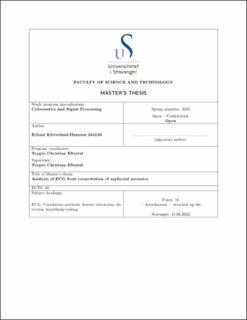| dc.description.abstract | Aim: Due to a high mortality rate for neonates with asphyxia in low resource countries, studies like this
emerge in hope to make a difference. Electrocardiogram (ECG) data is used in this project to examine
and analyze the data automatic. This project is associated with the research program Safer Births
https://saferbirths.com/. One goal of this project is to examine and obtain relevant information, which
can predict feature outcomes or determine early to initiate treatment on neonates. By reacting early, asphyxiated neonates can be given a higher survival ratio.
Methods: Two methods are used to perform this project’s analysis. The first method separate groups
depending on how much the patient’s ECG change during treatment. A change factor defines this change
and is depending on the morphology of the early and late patient’s ECG. Method number two, determine
groups based on similarities of patients ECG. Groups are created is based on the correlation clustering method.
The project methods are used in two experiments. Both experiments are based on the correlation method in
discrete time domain. Experiment one divide the ECG data into groups depending on the change factor. Three
different parameter settings for the experiment is performed to examine relevant similarities or discrepancies.
Experiment two creates ECG heartbeat category representations from clusters, early and late from the
neonates ECG data.
By performing experiment one, it is obtained results regarding the number of changed segments and how
much they change. With this knowledge in mind, experiment two examines the change (early to late) of the
created category representations.
Both experiments extract manual recorded and automatic detected features from the created groups or categories. These features are analyzed with hypothesis tests with the aim of detecting difference between groups and categories. Tables are made to get obtain common factors and significant differences from the experiments.
Results: Experiment one presents that most of the studied patients ECG-data do not change. However,
change of asphyxiated ECG symptoms can be observed in the different groups. Specific ECG related features
can be problematic to detect automatically. The change factor in this study is mainly not due to changes in
specific parts of the patient’s ECG.
Experiment two indicates common occurrences in categories, which may be because all patients have a degree of asphyxia. However, it is concluded that with early initiated treatment ECG-segments can improve slightly, but will rarely change category.
Conclusion: An analysis program was developed and demonstrated on the data set. Results display the
necessity for a sophisticated detection algorithm. Classification variables and results may require interpretation
by clinicians as a quality assurance. Combining results from both experiments give the following conclusion:
If a patient’s ECG-segment correlate at an early stage in treatment with a category representation from this
study (corr. coeff. ≥0.95), then the morphology of specific ECG parts will slightly improve with treatment,
but do not leave that category. | |
